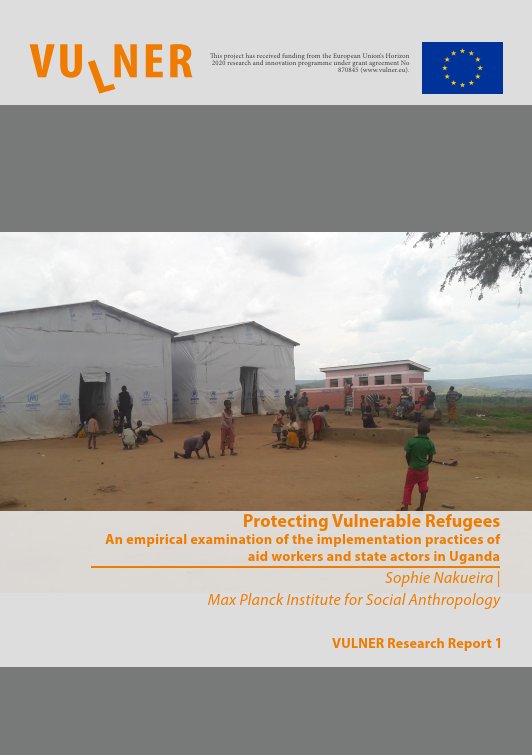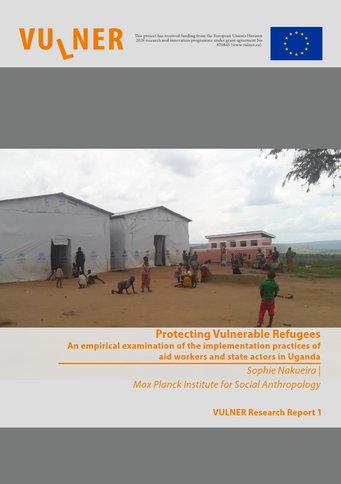Protecting Vulnerable Refugees
An empirical examination of the implementation practices of aid workers and state actors in Uganda - by Sophie Nakueira

This research report presents some of the intermediate research results of the VULNER project, based on the first phase of the project, which consisted of mapping out the vulnerability assessment mechanisms developed in Uganda by the office of the United Nations and High Commissioner for Refugees (UNHCR) and international aid agencies, including how they are implemented on the ground through the practices of the public servants and aid workers in charge.
The following research questions are addressed: What do the relevant domestic legislation, policy documents, and administrative guidelines reveal about how “vulnerabilities” are being assessed and addressed in the countries under study? Do the relevant state and/or aid agencies have a legal duty to assess migrants’ vulnerabilities, and if yes, using which procedures, when and how? Following which legal and bureaucratic criteria? How do decision-makers (street-level bureaucrats) understand and perceive the ‘vulnerabilities’ of the migrants they meet on a daily basis? How do they address these ‘vulnerabilities’ through their everyday practices? What is their stance on existing legal requirements towards ‘vulnerable’ migrants? Which loopholes do they identify?
To that end, a large number of Uganda legal sources and administrative guidelines were analysed. Additionally, diverse regional and international Conventions were assessed. Some reports and policies (e.g. National Development Plan II and III, reports on the progress of the Comprehensive Refugee Response Framework) do not feature prominently in the report but were nevertheless informative in understanding the nature of protection accorded to refugees and asylum seekers.
Interviews were conducted with 26 key interlocutors involved in the humanitarian operations. These included high profile key decision makers at headquarter level and street level bureaucrats at operational level) and comprised both public servants and international aid workers. Participants were from UNHCR, Office of the Prime Minister, Refugee Desk Kampala, Alight, Medical Teams International, Tutapona, Refugee Welfare Councils, War Child Canada and Windle International Uganda, among others. These agencies offer key protection services to asylum seekers and refugees in Uganda and have programs that prioritise special groups/persons based on specific vulnerability criteria. Observations were also conducted in limited spaces in Kampala at the Urban refugee desk and at OPM premises, where I was allowed to attend the training of Refugee Status Interviewing Officers.
The findings reveal that the formally prescribed architecture of protection (particularly, the identification, assessment and referral of the most vulnerable protection seekers) is hybrid and collaborative. It follows a whole-of-society approach and comprises both state and non-state aid workers at the local and international level who execute distinct aid programmes that are meant to complement those of other aid agencies. This whole-of-society approach aims to address the needs of the most vulnerable in the most holistic way possible, as well as generally, and in line with the Comprehensive Refugee Response Framework. Uganda’s policies and its collaborative architecture of refugee protection are Uganda’s strongest points and can be seen as an example that could be reproduced and tailored to other contexts.
Additionally, where gaps clearly exist, some national aid workers confessed to going above the call to intervene in cases where they felt that they could not simply look on and wait for bureaucratic procedure. Such discretionary practices that determined when and how aid workers or civil servants intervened beyond agency guidelines were driven by emotions (frustration or empathy). This suggests that emotions play a key role in aid workers practices and decisions in their assessments of vulnerable refugees.
Nevertheless, the findings revealed that factors such as constraints relating to funding, limited human capacity, and contextual challenges unique to specific settlements make it difficult to attain the desired protection goals in reality. The number of protection seekers that fits within the universal categories prescribed in the UNHCR guidelines as well as those unique to diverse agencies protection mandates and who are therefore eligible for intervention programmes – exceeds what most agencies can accommodate. The current pandemic has further exacerbated some of these problems (due to further cuts to funding and aid staff).
The findings suggest that even though some of the vulnerabilities experienced by protection seekers are within the law itself (such as the three-months timeline prescribed for granting and renewing temporary registration cards or the interpretation of a ‘permanent place of abode’ by judges in refusals to grant bail to refugees), many of the challenges are procedural and material. For example, spatiotemporal factors play a big role in exacerbating the vulnerabilities experienced by certain groups, such as those who have fled for political reasons and are in geographic proximity to countries they have fled, or elderly people who are at risk of having their food grabbed from them as they head from food distribution points.
Download the full report here.
